The design and fabrication of nanostructured materials are important for creating advanced functional devices. The enhanced and unique materials properties observed in nano-size regime are potentially useful for new technological applications. Our research is inclined to understand these structure-functional property relationships in functional nanostructures for potential applications in the areas of energy-harvesting, nanoelectronics, sensing and optics. We strive to explore ‘bottom-up’ processes for the synthesis of 'useful' nanostructures of a vast range of technologically important state-of-the-art as well as new materials. Our research projects are focused on the following aspects.
Nanostructured Ferroelectrics
Ferroelectric (FE) perovskite oxide materials exhibit long range
alignment of electric dipoles resulting in a net polarization
under an applied electric field. Due to this property and
other characteristics such as pyroelectricity and large dielectric
constants, FE materials have potentially become essential components
in a wide spectrum of applications such as nonvolatile
random access memory (NVRAM) and micro-electro-mechanical
(MEMs) devices. They are also being explored for various
sensor and actuator applications as high frequency
electrical components and tunable
microwave circuits. Multi-level nanostructure engineering in FE materials increases property efficiency. Our research is focused to synthesize size and novel shape controlled nanostructures of potentailly useful ferroelectric materials in order to study the effects of dimension on the properties of these materials. In one of our recent work, an innovative
physical/chemical combined synthetic-strategy involving
pulsed laser deposition (PLD) technique and hydrothermal process was explored for the first time to synthesize structure and orientation selective
synthesis of oriented Pb(Zr0.52Ti0.48)O3 (PZT) nanoheterostructures promoted by self seed-assisted nucleation method. As a result, we observed improved ferroelectric property as compared to
other reported values.
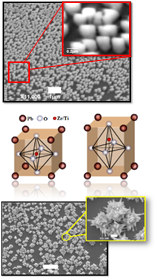

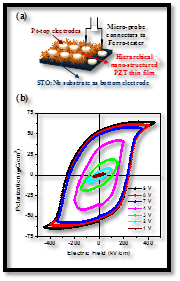
Another important direction of our nano-ferroelectrics research is to study the phase and ferroelectricity of environmentally benign perovskite and perovksite-derived materials based on the earth-abundant elements. In particular, we are focusing our research into Zinc- and Tin- based noncentrosymmetric (NCS) complex oxides due to their unique symmetry-dependent polarization properties. The down-scaling effect involves complicated interplay among structures (in nano- and micro-scale), surface charges, strain effects, and domain wall motions in these FE materials and results in changes in the long- and short-range ordering of dipoles. We have also started exploring the photovoltaic properties of these NCS perovskite FE materials in nanostructured form for future solar cell applications.

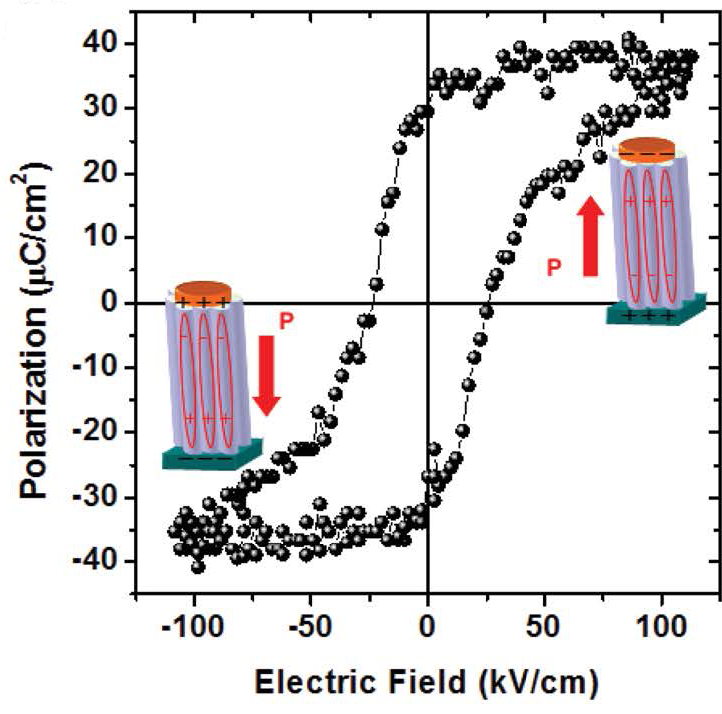
Structure-Property Relationshsips in Chalcogenide Nanostructures
Building on the current scientific knowledge base through the investigation of known materials is a very important aspect of our research. In this direction we focus to investigate novel growth and properties of Group II, III, IV and V metal chalcogenides nanocrystals with special attention in heterostructures (1-2-3 dimensional morphologies). Some of the key findings of our research as are, vapor growth of In2S3 zigzag nanowires for applications in solid-state diodes and GaS nanobelts and nanohorns possessing enhanced field emission properties, white-light emitting Eu doped In2S3 quantum confined nanoparticles and photoconductive ultrathin, monodisperse In2S3 nanoplatelets synthesized by low temperature polyol processes, solvothermally grown CdS aligned nanowires and CdS based core-shell nanowires with improved optical and electrical properties.

Nano-Thermoelectrics
Another direction of our research is in renewable, green energy-harvesting based on nano-thermoelectrics. Recent progress in higher efficiency theromoelectric (TE) materials can be attributed to nanoscale enhancement. Physically, nanostructured TE enhancement aims to split the interdependence of the electrical and thermal transport, allowing for greater optimization of the TE properties. One consequence of nanostructuring is the increase of interfaces since interface scattering of phonons and charge carriers play an important role in understanding the fundamental physics behind this enhancement. Our interest is to investigate the structure and transport properties (seebeck coefficient, thermal conductivity and electrical conductivity) of nanostructured TE materials in order to promote further insight and stimulate fundamental research in TE energy conversion technology. To this end, through our research we established that enhancement in the TE properties could be realized in many state-of-the-art TE nanocomposites, as compared to those of similar bulk compositions.
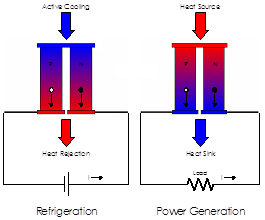
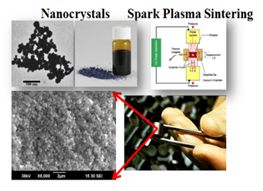
Other Research Areas
- Understanding the field-emission properties of cholcogenide and perovskite nanostructures
- Morphology dependent gas sensing properties of pervoskite nanomaterials